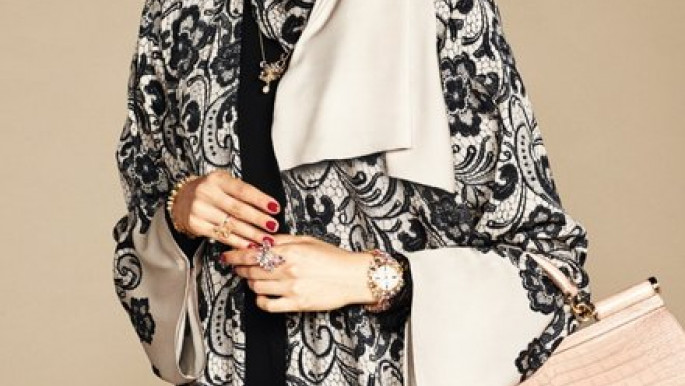What does D&G's abaya collection mean for Muslim women?
With Muslim women's attire already under such scrutiny in today's time, could Italian fashion house, Dolce and Gabbana's abaya collection help break the barriers?
4 min read
Due for release in Autumn 2016, the collection boasts a range of elegant abayas
If 2015 was the year that Kim Kardashian 'broke the internet', with a magazine shoot that left little to the imagination, then 2016 could be the year that fashion designers Dolce and Gabbana achieved the same by doing the complete opposite.
Social media was in uproar earlier last week when the D&G team unveiled a collection of abayas and hijabs.
Due for release in Autumn 2016, the collection boasts a range of elegant abayas in black and cream tones with a smattering of the signature D&G bold prints.
Known more for their daring designs (think dangerously short dresses and plunging necklines) the fashion, and Muslim, world were understandably gobsmacked, ecstatic and confused, all at the same time, when the collection was introduced.
It's been hailed by many on social media as ground-breaking, but D&G aren't the first, and certainly not the last, brand to recognise this gap in the market.
Last summer high street stores Zara, Mango and designer Donna Karen launched a Ramadan collection of modest dresses and loose clothing.
H&M also hit the headlines for featuring the first ever hijabi model in their campaign.
This sudden surge in modest clothing isn't coincidental.
Savvy fashion brands are cottoning on to the fact that there is a huge market for Muslims, especially in clothing.
A Thomson Reuters report predicts that by 2019 Muslims will be spending $484 billion on clothing and footwear.
The Arab market in particular continues to grow within retail and is already overtaking Asia and Russia.
 |
By 2019 Muslims will be spending $484 billion on clothing and footwear |  |
 |
|
Yes, you can get some very pretty abayas from the high street if you live in an ethnic area, and for those more remotely located there are some great small businesses that sell modest clothes online.
In fact, since the explosion of hijabi bloggers and vloggers on our computer screens, modest fashion has never been so popular.
Muslims and Islam have also never been under as much scrutiny and criticism as they have over the past decade.
Ongoing attacks from terrorist groups claiming that their actions are a part of the religion has not painted Islam in the best light.
Anyone who clicks on the Daily Mail website or walks past a Sun newspaper will see that Islam and its followers are misrepresented.
So when a press release pops up in my inbox celebrating Muslims and the Islamic attire, I can't help but feel a swell of pride.
Yes, those models are completely covered, but they look just as beautiful as the model adorned on the cover of Vogue.
However, not everyone shares this sentiment.
Hijabi bloggers and modest fashion designers took to blogs to share their disappointment.
Fashion designer and vlogger Dina Torkia blogged, “I can't help but feel incredibly underwhelmed, possibly even a tiny bit insulted by the collection.
"Fashion conscious Muslim women in the form of bloggers, designers and stylists have been taking centre stage for a good few years showing the world that modesty and style can coincide with faith.
"With barely a nod of applaud or recognition, until D&G fancies putting their stamp all over a very traditional middle eastern style and claim it's originality.”
 |
Fashion conscious Muslim women have been taking centre stage for a good few years showing the world that modesty and style can coincide with faith. With barely a nod of applaud or recognition, until D&G fancies putting their stamp all over a very traditional middle eastern style and claim it's originality |  |
Other than an excuse for the rich Emiratis to stuff their wardrobes with more high fashion pieces, it brings us recognition.
It recognises that women who choose to cover their bodies are not oppressed – they care about their appearance, wearing nice clothes and being fashionable too.
Since the recent terrorist attacks in Paris, I've heard several people tell their daughters, friends, cousins and so forth, that they should take off the abaya - after all, no one wants to be a 'sitting target'.
This pandemic fear of being attacked for our religion is very real, so when a mainstream brand like D&G launch a clothing line celebrating the very thing we've become scared of, it becomes somewhat reassuring.
It can educate the ignorant in a way that we can't.
Sami Rahman is a freelance writer based in London.
Follow her on Twitter: @bysamirahman







